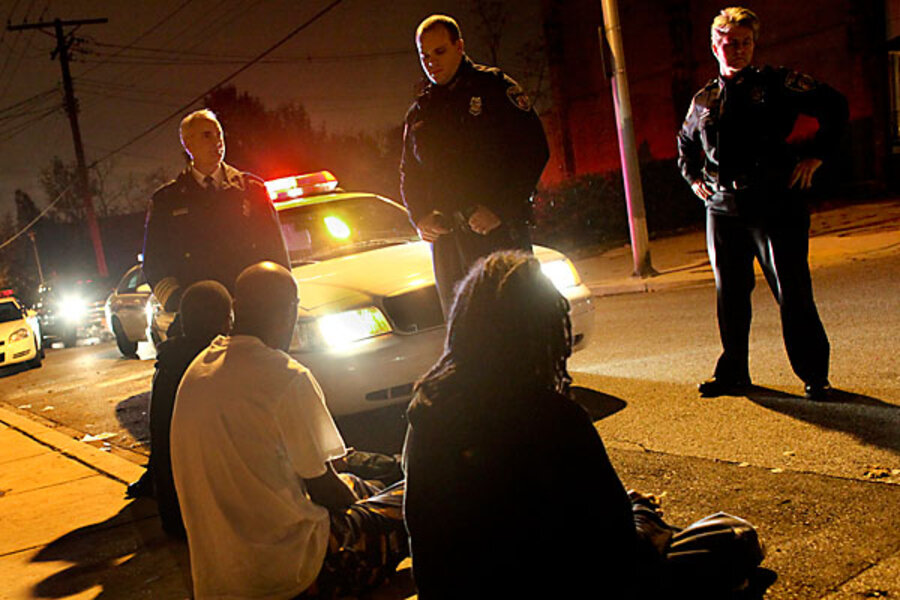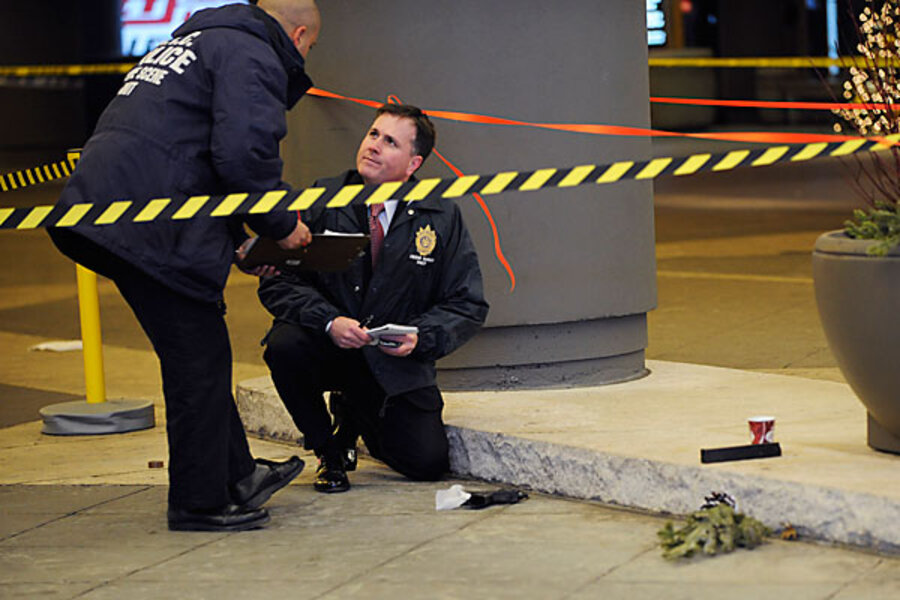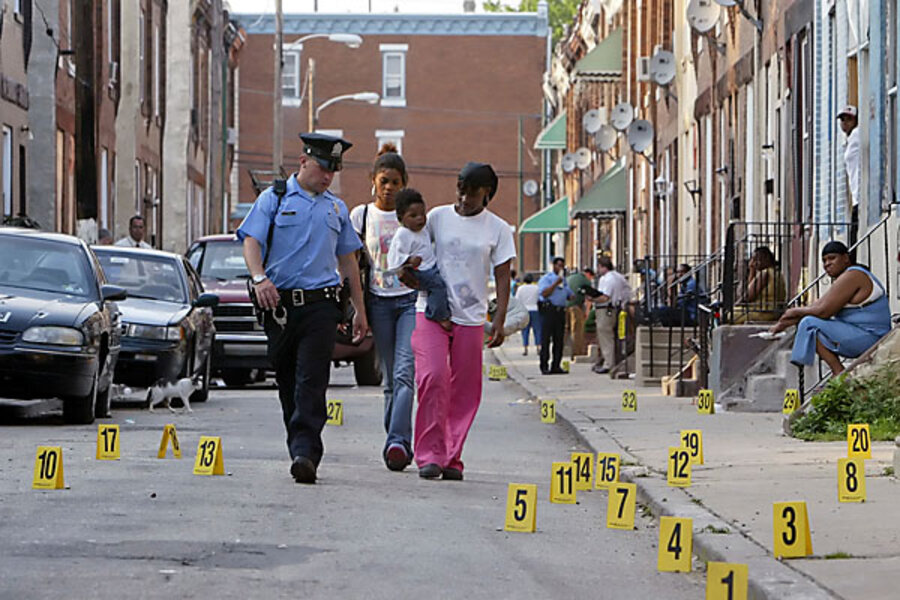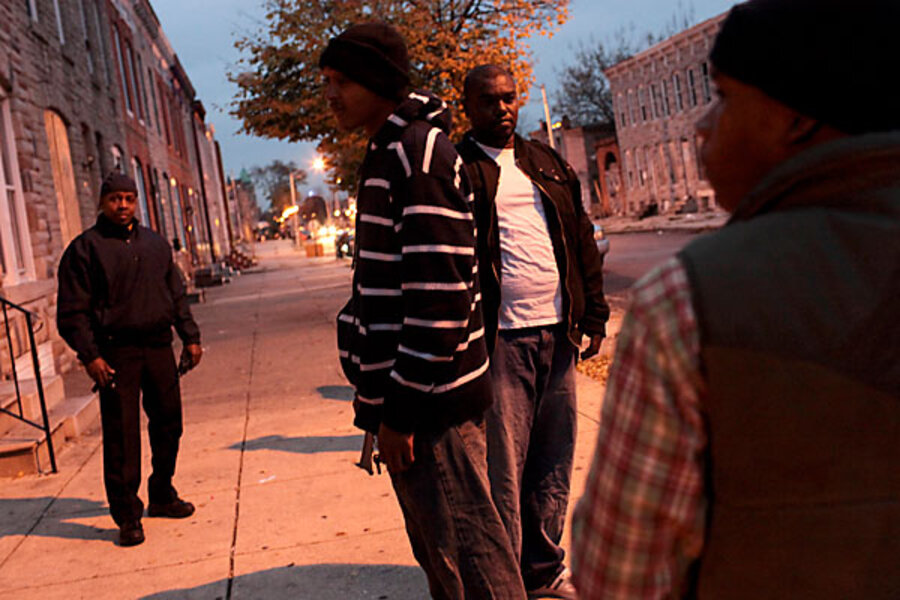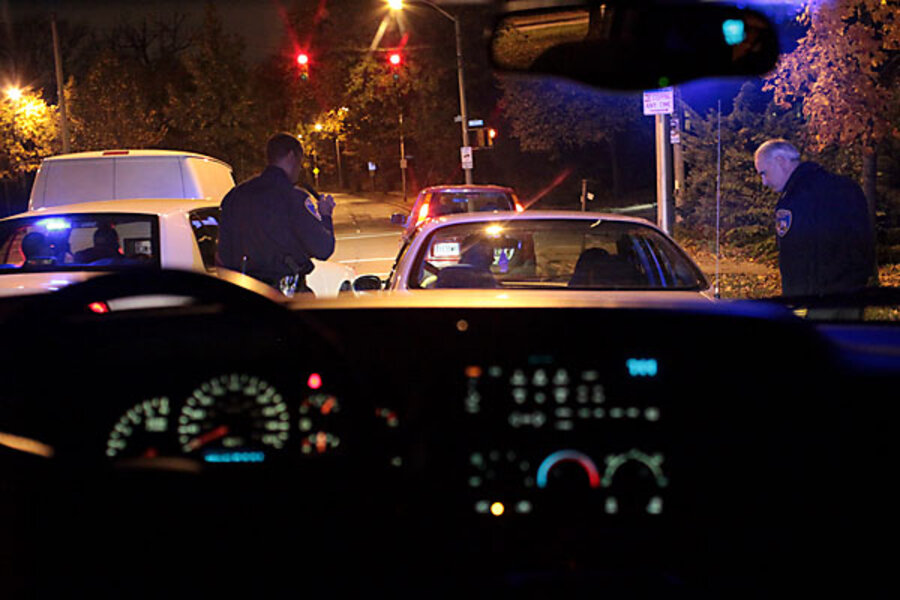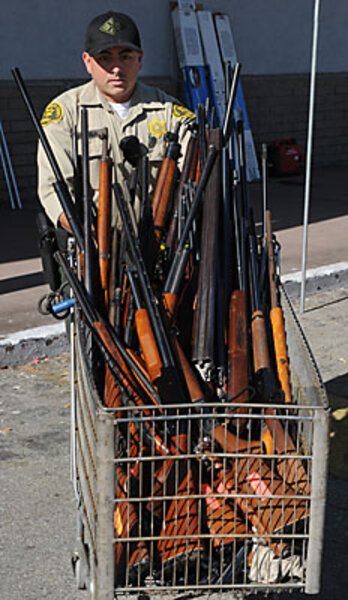Targeting guns to reduce violent crime
Loading...
| Baltimore
In the roll call room of Baltimore's Northwestern District Police Headquarters, a squat building in a neighborhood of liquor stores and crumbling row houses, photos of the city's most wanted suspects flash on a new, flat-screen TV.
They are not necessarily drug kingpins or murderers or even dealers. But to Police Commissioner Frederick H. Bealefeld III, they are top priority in this city with one of the highest homicide rates in the country; a city that residents occasionally, grimly, refer to as Bodymore, Murderland.
They are, he says, "bad guys with guns." And he wants them off the street.
"If you start boiling down the violence in Baltimore – the homicides and the nonfatal shootings – you find that 50 percent of all the people we charge with those offenses have one thing in common: They have gun offenses in their backgrounds," Mr. Bealefeld says. "And we know that when bad guys get out, they get guns again. They don't work for IBM. They don't hand out Bibles. They stand outside with guns waiting to perpetrate another crime."
And so, Bealefeld says, he has made it clear whom his officers should be targeting.
"I don't aim to make [it] all that complicated," he says. "Find out all we can about gun offenders and focus on those guys."
After years of fighting the so-called "war on drugs" – the obsessive pursuit of everyone involved in drug crime, from users to dealers to suppliers – Bealefeld and other urban police chiefs nationwide are shifting their focus toward a new prime target: gun offenders.
This law enforcement philosophy is born of the growing acknowledgment that millions of dollars and arrests have done little to slow urban America's drug trade, and that a fresh strategy is needed to further reduce violence in the country's toughest cities. From new gunshot-detection cameras in New Haven, Conn., to a gun-offender registry in Baltimore; from a Sacramento, Calif., law requiring gun dealers to notify police about people who buy bullets to a proposal approved by the Los Angeles City Council that would let landlords evict tenants convicted of gun crimes, city police departments and governments are putting new emphasis on fighting illegal guns.
The shifts are local, differ from city to city, and are largely beneath the radar of the national gun control debate. Yet taken together, it is a sea change in how cities are attempting to tackle what has often been viewed as hopeless, ingrained urban violence, say criminal justice analysts.
"You're never going to stop the drug trade," says Sheryl Goldstein, the director of the mayor's office on criminal justice in Baltimore.
"For a long time, many police departments in this country really focused on the war against drugs – they believed that drug trade sparked violence…. [Now] we're seeing a shifting of that focus to gun trafficking and getting guns off the street."
* * *
Baltimore, under the guidance of Bealefeld, shows one of the clearest breaks with old police strategy.
The commissioner has encouraged his officers to focus their efforts on gun crime, even if that means letting some drug arrests slide. The "bad guy" with the gun, he says, is the focus.
"When my cops pull up to a corner, what I want them to do is look for that guy first," Bealefeld says, pointing to a face on the flat-screen. "The 15-year-old with three bags of weed? He's going to drop the weed and run and lead them on a four-block foot chase. The guy with the gun, with the baggy pants and no belt? With the Glock jammed down there? He's going to saunter off very quietly. He's been arrested before; he knows what cops do.… I want my cop to get out of my car and say, 'Run, Forrest, run. But you sit down. I'm talking to you."
Bealefeld's strategy is multipronged: He has created a gun-trace task force, coordinated more closely with parole officers, and has worked with city and court officials to develop a gun offender registry – one of the first in the country – that tracks his "bad guys" much the way sex offender registries do.
For example, on Dec. 17, police got a tip that a man named Marcus Ellis was involved in a narcotics deal. After checking with parole and probation officers, the police realized that not only was Ellis on probation for recent drug offenses, but he also had a history of handgun violations.
They quickly got a search warrant, and found that Ellis was carrying a semiautomatic 9mm handgun. These sorts of arrests happen regularly, Bealefeld says.
Although Baltimore has made some of the boldest moves to target illegal guns, and is unique in the extent of its gun crimes – during the past decade, the number of nonfatal shootings has neared 1,000 a year in this city of 600,000 – it is not alone in the way that the focus of law enforcement has shifted.
Though national rates of robbery, murder, and rape have fallen since the 1990s, gun violence in inner cities has persisted or increased. Criminologists at Northeastern University in Boston, Mass., for instance, released a study in early 2009 showing that the number of young black men and teenagers who either killed or were killed in gun crimes has increased 40 percent since 2000.
To fight this trend, police departments across the country have put more resources into gun units, prioritized gun arrests, and have worked with federal prosecutors to take gun cases into federal court. City leaders have also joined the effort; in just the three years since New York Mayor Michael Bloomberg and Boston Mayor Thomas Menino created Mayors Against Illegal Guns, the active group has grown from 13 members to more than 450. Also, in some large cities, health departments have increasingly supported peer-to-peer antigun efforts, many modeled on the successful Ceasefire programs in Chicago and Boston, where former gang members help mediate conflicts before anyone resolves them with a gun.
"There is a variation in how [different] cities and departments have approached the problem of firearms," says Richard Rosenfeld, professor of criminology and criminal justice at the University of Missouri, St. Louis. "There is a variation when it comes to strategy. But across the country, there has certainly been a heightened focus on reducing firearm crime. And privately, many will say that the drug war has been ineffective and a waste of public resources."
It is not as if any police department is giving up fighting drug crime, however. According to the US Bureau of Justice Statistics, drug-related arrests continue to rise. In 2007, there were more than 1.8 million drug-related arrests – most for drug possession – compared with 1980, when the number was less than 600,000. Even in police departments such as Baltimore's, where guns are the explicit priority, it will probably take years before there is a full institutional adjustment, criminal justice scholars say.
"I think that there is a shift," says Daniel Webster, the head of the Johns Hopkins University Center for Gun Policy and Research. "I think it can be shifted more.… I see more big-city departments putting greater resources to the gun effort, but you don't change institutions overnight.
"In my mind, the direction they should be heading is [toward] devoting fewer resources to disrupting illegal drug markets and more resources to disrupting illegal gun markets. They've been trying to fight this drug war for eons and they really haven't been effective.... Sometimes it is even counterproductive – we know that drug markets are most violent when they are destabilized."
* * *
Taking aim at gun crime has its roots in the early 1990s, when police departments and city governments started experimenting with new ways of fighting the crack cocaine wars that had propelled homicide numbers to record highs, says Hubert Williams, president of the Police Foundation. Gun buy-back programs, background checks, and, in some cities, out-and-out handgun bans were some of the measures put in place to get a handle on growing urban violence.
One well-known program, which, unlike many of the other efforts, had the support of the National Rifle Association (NRA), was "Project Exile" in Richmond, Va. Here, federal and local law enforcement teamed together to literally exile convicted gun offenders from the region; because of the federal system's stricter sentencing laws and its expansive federal prison network, someone convicted of illegal gun possession not only got more time, but often served it hundreds of miles away from friends and family.
"For some people, when they get up in the morning, putting on the gun is like putting on their pants," Mr. Williams says. "And the question was, is there a message that we can get to these primarily young adults and kids that are carrying the weapons? In Richmond, police handed out cards that said, 'Carrying a gun will get you five.' At some point the message got through."
There has been much debate about Project Exile's effectiveness, however. Although killings in Richmond dropped 30 percent, critics claim the reduction was due to other factors, and that similar cities saw even greater declines without a comparable program. Williams says efforts to expand Project Exile to other jurisdictions fell flat, in large part because federal judges believed it was the responsibility of state courts to handle gun crimes.
Other innovative efforts against illegal guns "came to a screeching halt in 2000 with the Bush administration and a new Congress," says James Fox, a law and criminal justice professor at Northeastern University. Congress, for instance, passed laws that restricted local law enforcement's access to Bureau of Alcohol, Tobacco and Firearms (ATF) gun trace data; the NRA continued to oppose any efforts to limit gun trafficking or sales.
Many in city government and law enforcement see the gun control debate as a large obstacle to more effective gun prosecutions.
Although those involved in the growing effort against illegal guns are quick to say that their focus is not about gun ownership rights, but about criminal behavior, they also acknowledge that it has become difficult in the United States to talk about any sort of gun regulation without delving into the emotional, larger debate. And one component of police and city efforts to target illegal firearms is, in fact, stricter legislation – both state and federal.
In Maryland, for instance, Baltimore city representatives have pushed the state legislature to pass tougher gun penalties. In Massachusetts, proponents have asked for tougher sentencing laws and the ability to hold gun offenders without bail. Mayors Against Illegal Guns has lobbied for changes to federal law, asking the Obama administration to allow the ATF to release to local officials more gun trace data. It has also supported legislation to block people on terrorism watch lists from purchasing guns and has pushed for an end to so-called gun-show loopholes, in which unlicensed firearms sellers can sidestep background-check requirements.
All of which sound warning bells to gun rights groups such as the NRA.
"The NRA has been on record for decades talking about strict and unequivocal prosecution of gun crimes," says Andrew Arulanandam, spokesman for the NRA. "The problem with groups like Mayors Against Illegal Guns is that they are actually a group that proposes gun control legislation, which will only affect law-abiding citizens. If you would just do some rudimentary research on existing gun laws and penalties that apply to them, you would find that existing laws are adequate."
It's already a crime for a convicted felon to have a gun, so further regulation is overkill, reason those who oppose gun controls.
The NRA has urged its members to put pressure on politicians to leave the group.
For its part, Mayors Against Illegal Guns insists it supports Second Amendment rights. But the strident response from the gun lobby discourages national politicians from advocating changes to gun laws, say those working for more gun regulation.
"It's been a toxic issue," says John Feinblatt, Mayor Bloomberg's criminal justice coordinator. "The Democrats don't want to touch it because they blame their losses in '94 on it. It's become a political hot potato. But the mayors know this isn't about politics. This is about people's lives."
For now, says Robyn Thomas, executive director of the Legal Community Against Violence, the movement against illegal guns is likely to have most success on a local level.
"There is more political traction now in cities," she says. "That's where we're seeing the change."
still, as baltimore shows, this change can be significant. Since Bealefeld took the commissioner job two years ago, with the explicit goal of targeting gun crimes, homicide numbers in the city have dropped to record lows. The 234 murders in the city in 2008 was the lowest annual total in two decades; by Dec. 29, 2009, the city had 235, indicating a sustained trend rather than – as usually happens in Baltimore – a one-year dip.
Nonfatal shooting numbers have also dropped. In the early 2000s there were close to 1,000 nonfatal shootings in Baltimore annually; by Dec. 29 of 2009 there were 447 – down 23 percent from last year. And over the past two years, the department has seized 5,000 illegal guns – a number that equals 10 percent of the guns sold legally in Maryland, but only a fraction of the illegal firearms police believe are in the city. (In New York, a city with a population more than 10 times that of Baltimore, police only confiscated about twice that number.)
Other cities engaging in the new focus also show progress.
Boston, for instance, which put a gun buy-back program into effect in 2006 after a spike in gun violence, has seen a decrease in nonfatal shootings – 323 in 2006, 273 in 2007, 274 in 2008, and just 191 as of Dec. 13, 2009. In New York, after years of refocused enforcement, police are finding fewer illegal guns on the street – 7,059 in 2006 and 5,913 in 2007, for example. "I am just so convinced, and so animated, about this notion of going after gun violence," Bealefeld says. "Because we've been debating about the efficacy of drug enforcement, and whether we should legalize drugs, or what we should do about drugs, blah blah blah blah blah drugs forever. You can't get five people to agree on it. But I could get 500, I could get 5,000, I could get 500,000 to agree that one guy with a gun constitutes a danger to them. I can." •



